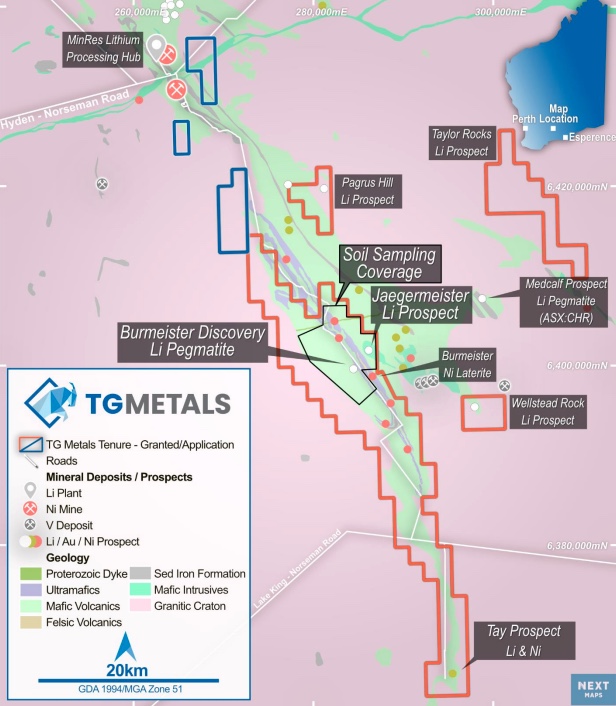TG Metals prepares to unwrap four new lithium targets at Lake Johnston

Four priority lithium targets have been defined at the Lake Johnston project which are substantially larger than the anomalies that delivered the Burmeister discovery. Pic via Getty Images
- Several lithium geochemical trends have been defined over a strike of ~8km
- These four targets are the largest and most geologically connected, TG6 says
- Approvals for first drilling over these new areas are well advanced
Special Report: Assays from an infill and extension soil geochemistry program at TG Metals’ Jaegermeister prospect have defined lithium trends over a strike of ~8km, an area encompassing the highest priority targets for future drilling.
TG Metals (ASX:TG6) has now defined four drill targets at the Lake Johnston lithium-nickel-gold project in WA, with some larger and of higher-grade than the soil anomaly which defines the Burmeister lithium discovery.
Burmeister, part of the company’s Lake Johnston project, was the subject of a drilling campaign carried out in October last year and subsequent drilling since which reeled in grades up to 3.09% Li2O.
The Lake Johnston district saw an uptick in interest following the Burmeister discovery from ASX junior explorers such as Torque Metals (ASX:TOR), Charger Metals (ASX:CHR) and Bryah Resources (ASX:BYH), as well as major mining houses Mineral Resources (ASX:MIN) and Rio Tinto (ASX:RIO).

Lake Johnston and surrounding projects. Pic: Supplied (TG6)
According to TG6, Burmeister’s soil geochemical anomaly is ~500m long at greater than 1,200ppm Li2O, with drilling so far having identified spodumene-rich pegmatites over a strike of around 2km.
NOW READ: MinRes remains bullish on lithium and it could take a host of WA explorers along for the ride
Four targets for future drilling
The four targets defined for future drilling include Target A, B, C, and D.
Target A is a high tenor lithium soil anomaly that occurs on a prominent local elevation, covering an area of 1000m by 800m with peak Li2O of greater than 200ppm.
Target B is a circular high tenor lithium anomaly, which appears to be related to the Target A anomaly, is around 500m in diameter.
Both Targets A and B are within areas of outcrop, subcrop and thin skeletal soils and boast similarities with the Burmeister discovery area, making these two targets the highest priority for drilling.
Target C, on the other hand, is 1.5km in length, on the western edge of an interpreted flood plain.
TG6 says it is interpreted to be an in-situ +1,200ppm lithium in soil anomaly three times the size of the same amplitude anomaly over the top of the Burmeister lithium pegmatites, making Target C a large drill target.
Meanwhile, Target D is within relict flood plain material and as such there is reduced confidence in the soil anomalism. Despite this, the high tenor anomaly is within a structural and lithological trend extending from Target B.
On the horizon
Flora and fauna surveys have been completed and heritage surveys resumed following a pause due to rain on site.
Maiden drilling at Jaegermeister will begin upon POW approval in areas where heritage surveys have been completed.
An infill drilling program at Burmeister is awaiting POW approval where another heritage survey is underway to allow 100m infill drill lines.
Seismic trials over Burmeister and Jaegermeister to aid with drill targeting are due to kick off in March and will run for about 10 days of data acquisition, followed by five days of data interpretation.
The first metallurgical test work is expected to begin in the coming weeks.
Core samples are now at the laboratory and a flowsheet for the test work has been set.
This article was developed in collaboration with TG Metals, a Stockhead advertiser at the time of publishing.
This article does not constitute financial product advice. You should consider obtaining independent advice before making any financial decisions.
Related Topics

UNLOCK INSIGHTS
Discover the untold stories of emerging ASX stocks.
Daily news and expert analysis, it's free to subscribe.
By proceeding, you confirm you understand that we handle personal information in accordance with our Privacy Policy.








